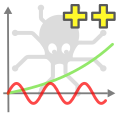New: The Yocto-MaxiCoupler-V2
![]() Relays are one of the most fundamental components used in automation: opening and closing a circuit is the most intuitive way to remotely control a machine. We offer several kinds of USB driven relays, depending on the type of circuit to be switched. But we also have an alternate choice: solid-state relays, solely based on semiconductors. And on this topic, we have fresh news...
Relays are one of the most fundamental components used in automation: opening and closing a circuit is the most intuitive way to remotely control a machine. We offer several kinds of USB driven relays, depending on the type of circuit to be switched. But we also have an alternate choice: solid-state relays, solely based on semiconductors. And on this topic, we have fresh news...
| No comment yet | Read more... |
Yocto-Graph improvements
![]() This week, we are going to talk about our Yocto-Graph Android application. At the beginning, this application was designed as a usage example for the data logger, but some customers find it convenient and have asked use whether we could add network support to it, in order to use Yoctopuce modules connected to a YoctoHub. We therefore decided to add network support to the Yocto-Graph.
This week, we are going to talk about our Yocto-Graph Android application. At the beginning, this application was designed as a usage example for the data logger, but some customers find it convenient and have asked use whether we could add network support to it, in order to use Yoctopuce modules connected to a YoctoHub. We therefore decided to add network support to the Yocto-Graph.
| No comment yet | Read more... |
News of Yocto-Visualization
 As the Yocto-Visualization application is very successful with our customers, we keep improving it, naturally by fixing bugs, but also by adding new features. These new features come up regularly, but they are not advertised: one must usually read the release notes to know what each new version brings. This week, we sum up key changes that have occurred over the past year.
As the Yocto-Visualization application is very successful with our customers, we keep improving it, naturally by fixing bugs, but also by adding new features. These new features come up regularly, but they are not advertised: one must usually read the release notes to know what each new version brings. This week, we sum up key changes that have occurred over the past year.
| No comment yet | Read more... |
Exporting consolidated measures in CSV format
![]() Among the questions that regularly come up for Yoctopuce support, we find in good position the question of how to generate a CSV file with data recorded by several sensors. So, to save you some time, we finally decided to add this function directly in the programming library.
Among the questions that regularly come up for Yoctopuce support, we find in good position the question of how to generate a CSV file with data recorded by several sensors. So, to save you some time, we finally decided to add this function directly in the programming library.
| No comment yet | Read more... |
Install Yoctopuce tools with apt-get
![]() We have added a new installation method for our applications that should delight Linux users. You can now install the VirtualHub, the command line library, the Yocto-Visualization, the Yocto-BridgeCalibration, and the Yocto-Discovery using apt-get.
We have added a new installation method for our applications that should delight Linux users. You can now install the VirtualHub, the command line library, the Yocto-Visualization, the Yocto-BridgeCalibration, and the Yocto-Discovery using apt-get.
| 2 comments | Read more... |
1 ... 10 ... 20 ... 30 ... 40 ... 50 ... 60 ... 63 64 65 66 67 68 69 70 71 72 73 ... 80 ... 90 ... 100 ... 110 ... 120 ... 130 ... 140 ... 150 151


